
part of Funding The Frontlines: A Roadmap To Supporting Health Equity Through Abortion Access
Home: Health Equity -- & Abortion Access -- Must Be Gender Affirming
For trans and gender expansive communities, the dollars dedicated by philanthropy comes woefully short. According to Funders for LGBTQ Issues, for every $1 million awarded by the sector, just $400 are allocated for transgender/nonbinary people, with $88 set aside for transgender/nonbinary health and well-being, and just under $11.44 was for sexual and reproductive health for trans and nonbinary people. Meanwhile, each year about $448 of every $1 million given by US foundations goes just to Harvard alone.
The lack of support goes beyond money. Philanthropy has long been a catalyst for cis-gender leaders of the sector to create narratives from the margins we do not sit at, and it is time to disrupt that through wielding and yielding both our power and our platforms.
So, this section of the road map will follow the abortion of We Testify storyteller Nick, as they share the moments leading up to their abortion and experience behind clinic doors as a transgender person.

Nick explains what storytelling means to them and how it impacts the work they now hold on the frontlines supporting others seeking abortion services.
My abortion storytelling experience has been beautiful, because for the first time in my life, when I went on the we testified Texas retreat, I was in a room filled with people who had had abortions, and only people who had had abortions. That was such a powerful experience. And it was an experience that I didn’t even know I needed. I can say that one thing that abortion storytelling gave me was permission to take up space in the movement like, “hey, my story as a trans person who’s had an abortion is important”. And, you know, it kind of gave me the clarity of purpose to talk to my own abortion fund about ways that I felt like we could better center people who have had abortions in our work. Those are conversations that I wouldn’t have thought to have before being in an environment just talking with other abortion storytellers.
Hearing Renee talk about how across the movement, the one issue we have is that we don’t listen enough to abortion storytellers. People who have had abortions are honestly kind of marginalized in the movement, our experience is not really seen as valid or important. Sometimes abortion storytellers, or people who have had abortions at all will get shut down when trying to refer to our own experiences and we have a lot to share with the movement.
I’ve met some of the most incredible people. I’ve met other transgender people who have had abortions, and that’s huge for me, because when I was getting my abortion, I felt so alone, I felt like the only trans person getting an abortion.
And logically, I knew that wasn’t true. But I didn’t know anyone. I had never seen a transgender person talk about getting an abortion before.
That was in 2017. I think there were a couple of people who were who were talking about it then, but I just hadn’t seen anything like that.
I really think that what I’ve seen since I became an abortion storyteller in 2019, is more and more people have shown interest in hearing about these stories and sharing these stories. People will explicitly ask to hear from transgender abortion storytellers now.
I think that’s enormous, because I think that it is important to make sure that other trans people know that they’re not alone. I want other trans people to know that it is important that you receive good, gender affirming health care. It matters. And I think that having transgender abortion storytellers makes that very clear.
We’re there to make sure other trans people are heard and being visible so that people don’t feel so alone. I’m really honored to have the platform I have, because I want to make sure that other trans people don’t go through what I went through, and that other trans people don’t have that same sense of being alone.
As we follow Nick’s abortion story, NCRP will present data and figures, to accompany their narrative. This research is not displayed to validate or justify the experience that Nick is sharing with us. But to reveal the gaps that grantmaking has manufactured that trap trans men, intersex individuals, cisgender women, nonbinary people, and gender non-conforming folks seeking abortions services.
 I’ll just start from the beginning. My name is Nick, and I use they/them pronouns, I got an abortion in Houston, Texas in 2017, when I was in my mid 20s. At the time of my abortion, I was unemployed, and I was on government health insurance.
I’ll just start from the beginning. My name is Nick, and I use they/them pronouns, I got an abortion in Houston, Texas in 2017, when I was in my mid 20s. At the time of my abortion, I was unemployed, and I was on government health insurance.
I was living in a three-bedroom apartment with four people, and we really did not have the physical space for a baby, nor did I really have the emotional bandwidth to be a parent at that point in time. I did not have a job, and I really did not have the money to take care of myself during a pregnancy.
 I knew that even if I had found a job immediately, I would not have been eligible for even unpaid leave because the FMLA [Family and Medical Leave Act] only kicks in after you have been at a job a year, and since I was already pregnant, I did not have that kind of time before I would have been eligible for leave. Even if I had had the money, I just would not have been guaranteed to have a job at the end of my pregnancy.
I knew that even if I had found a job immediately, I would not have been eligible for even unpaid leave because the FMLA [Family and Medical Leave Act] only kicks in after you have been at a job a year, and since I was already pregnant, I did not have that kind of time before I would have been eligible for leave. Even if I had had the money, I just would not have been guaranteed to have a job at the end of my pregnancy.
I was looking for more stability than that, that was not the level of instability that I could handle at that point. If I found a job, I would be my family’s breadwinner and be the person carrying the insurance. I just knew that I could not have a child, I was not able to raise a child.
 My health care needs also complicated things a great deal
My health care needs also complicated things a great deal
in that one of my medications is not something you can take while pregnant and it is a core part of me managing my health. So, I would have had to have immediately reworked my entire treatment plan to take care of myself.
I just did not really have the ability to do that. In addition to everything else, the pregnancy was causing a drastic increase in my symptoms. I was not really set up to have a healthy pregnancy. I just knew that it would not end well, either for me or a potential child.
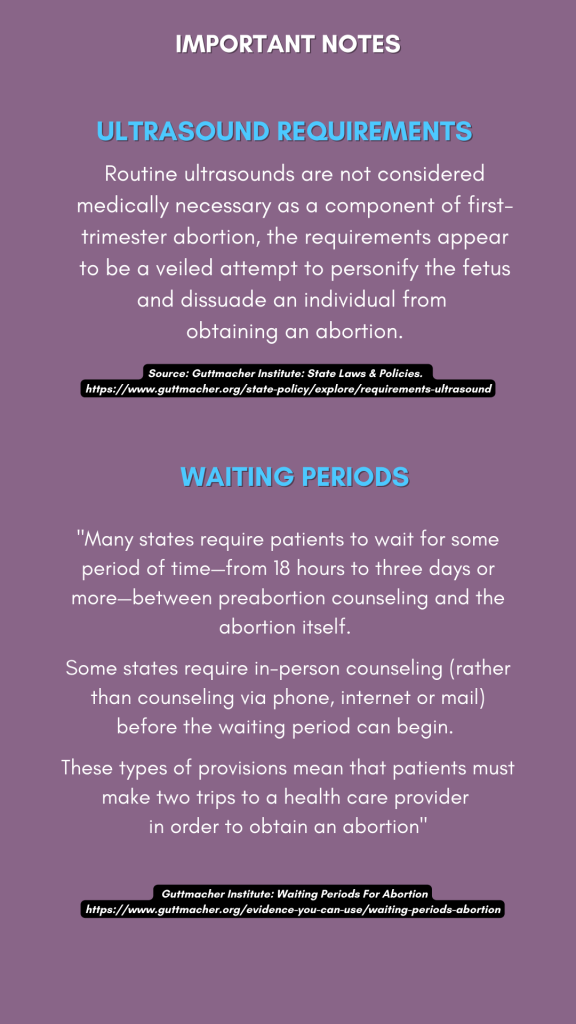 I knew of one big name provider in town, and I immediately called them, but they could not get me in for my first appointment for a full week.
I knew of one big name provider in town, and I immediately called them, but they could not get me in for my first appointment for a full week.
In Texas, you must have two separate appointments. One of those appointments is for a medically unnecessary ultrasound, and then you must wait 24 hours before your procedure itself. So, you do have to make two separate appointments and
two separate trips.
I did not want to wait another full week being pregnant before I could even have my first appointment.
I did a Google search and I looked very carefully to make sure that I was not going to be bamboozled by a crisis pregnancy center, I went directly to the website and saw testimonials regarding abortion care and saw that I was
in the right place. I gave them a call and they could get me in the next day for my first appointment. So, I was like, now we’re talking.
I am not fucking around with this. I got my abortion that Saturday. I could have gotten my abortion sooner than that, but my partner at the time was only available to take me on Saturday and I really wanted the emotional support.
I didn’t know about the abortion fund I later worked for, where I could have gotten a ride. But really, I did want the emotional support, you know, from my partner.
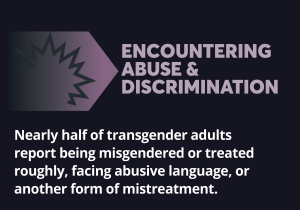 When I called the abortion clinic, I ended up crying on the phone, because I was afraid of being misgendered. I was afraid of going through an experience where I was going to be misgendered in addition to it just being a medical procedure. Then all of the cultural baggage that goes along with abortion in the United States, and my fear of having an experience that would be very [intelligible] – that would cause me a lot of gender dysphoria.
When I called the abortion clinic, I ended up crying on the phone, because I was afraid of being misgendered. I was afraid of going through an experience where I was going to be misgendered in addition to it just being a medical procedure. Then all of the cultural baggage that goes along with abortion in the United States, and my fear of having an experience that would be very [intelligible] – that would cause me a lot of gender dysphoria.
I already kind of had a fear of health care providers because I had had some bad experiences, and this was just an incredibly vulnerable time. The person on the line, reassured me and said, “don’t cry, we’ll get you scheduled for an appointment. We’ll put down the name you want. It’s fine, we’re going to take care of you.”
And so, I did. I went and got my abortion there.
My first appointment was the ultrasound, and the technician was like, “Well, I have to describe this for you.” I personally didn’t mind because I was curious. I looked because I was curious. But it was just one of those moments that was like this should not be happening, like this is clearly a guilt trip. It was just kind of one of those things that was like this whole thing is completely unnecessary.
 And then came the counseling session, I actually had a counselor
And then came the counseling session, I actually had a counselor
who was informed about trans issues and it was affirming.
I felt seen, and I felt affirmed.
That was something that I was really shocked by. I did not think an abortion clinic would have someone on staff who knew the
first thing about trans issues.
Of course, as part of the counseling session, you have to be told a bunch of inaccurate information, which, you know, and I know is inaccurate.
You know it is inaccurate but coming for someone who is not super familiar with the field and the laws around this, having this government mandated discussion and brochure, I am sure is really alarming.
I’m like, okay, none of this is true. But, you know, it is deliberately set out to mislead and trick people. And it is just completely awful.
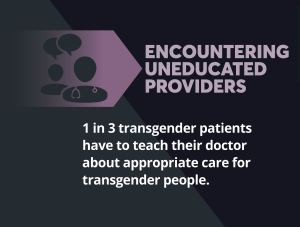 So, I waited until Saturday, and I was warned. My counselor warned me because I said, “I think I’ll get it done on Saturday, that’s when my partner is off.”
So, I waited until Saturday, and I was warned. My counselor warned me because I said, “I think I’ll get it done on Saturday, that’s when my partner is off.”
And she warned me, that is when the protesters come.
She said they are led by this young guy, every week, this same dude, and his band of merry followers come to scream at vulnerable people getting health care.
Boggles the mind. But I went to get my abortion and, you know they’re standing there, it is one gate in and one gate out, and they are standing at the front gate to choke you as you go in like, to make you feel crowded, and everything.
They’re waving their hands in front of the windshield and trying to stick stuff on our windshield, and yelling at us, and the clinic escorts, God bless them, are just like waving us in to get over the threshold because they cannot touch you after that.
So, then we parked and as we’re walking inside, one of them screams at me, “Don’t kill your baby.”
It was just one of those things where, you know, before it happened, I would have liked to have thought that I just gave him the finger or something. But I was just really vulnerable and horribly sick because the morning sickness hit me hard and I’m just trying to get this private medical procedure done.
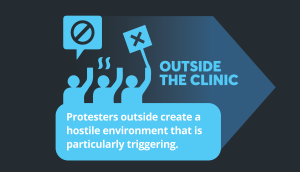 People are like, staring at me and screaming at me. It’s just incredibly humiliating, degrading, and invasive, and they know it.
People are like, staring at me and screaming at me. It’s just incredibly humiliating, degrading, and invasive, and they know it.
That’s exactly what they are trying to do there. You know, because by the time someone is there, they know that they are not going to get people to not abort. They’re just trying to make them feel shitty about it. And it was just a really awful thing to go through
I don’t remember much about their signage, honestly. I seem to remember it was like, those graphic design is my passion signs, a lot of really crowded text and clip art, and the whole thing looked like an unholy mess, and my brain could not process it. There was a lot going on there, I want to say they had an image of Mary, I’m not sure.
I am pretty sure that their signage said something about mothers and motherhood or something, but I was not really paying attention and the stuff they were screaming was gender neutral.
So, I guess there is that, but it was one of those things where it was definitely a misogynistic attack, because that’s the thing about, you know, trans people and abortion, the attacks are misogynistic.
It’s basically targeting transgender people with misogyny, which in addition to being horrible on the grounds of it being misogyny, it’s also gender invalidating, to have misogyny leveled at you and a lot of times there is a twisted element of transphobia via misogyny as far as, “I’m going to misgender them by applying misogyny.”
It’s one of those things where, as a trans person doing abortion access work, I realize that attacks on abortion are rooted in misogyny. But along with that misogyny it’s wrapped up with white supremacy, it’s wrapped up with cissexism and transphobia. You know, it’s wrapped up in Christian supremacy.
So, it’s misogyny, but it’s not misogyny alone.


Everything was okay. In Texas, they do take your ID, because there is the age stuff so, they do have your legal name on the forms. They did mark down my name, call them Nick, but I still did get called by my dead name. Not maliciously, but because they were looking at the name field, and they were not looking at the secondary field.
And so, it was a little bit unfortunate and a little bit jarring, but people were respectful to me. I didn’t really have an issue with how I was treated. I would say that, as far as feedback to the providers, I think the best doctor’s experience I had was a primary care physician who was very trans informed, who on their forms had preferred name up top and legal name under it. So that way, the first name you are seeing is what the person wants to be called, it is a small change to the paperwork that could make a huge difference.
I also think just having the staff informed on trans relevant care, and the fact that transgender people get abortions, because not everyone getting an abortion is a woman. I think that having that would also help. They did have a nice piece of literature that they sent us all home with, that was basically like, “the protesters do not know who you are, they do not know what they are talking about, you are still a good woman.” Making something like that gender neutral, I think would go a long way as well.
 But I also thought that that was a nice touch to send you home with something to remind you that the protesters are not the final arbiter of who you are. They do not know anything about you.
But I also thought that that was a nice touch to send you home with something to remind you that the protesters are not the final arbiter of who you are. They do not know anything about you.
I think other than that, assumptions of gender, gendered décor, gendered brochures, and gendered information – taking a fresh look at that and seeing where can they make this neutral. Or is there a way that we can talk about this in a way that does not exclude people?
I think also, there has been some discussion on what language to use for anatomy in a way that is affirming to people. Research needs to be done on that, because obviously, I’m just one trans person, my preference is only mine. And I would actually love to hear from other trans people who get abortions, how they would like their bodies referred to. I think that would be important information to have as well.
One thing that’s really important that goes along with the research aspect of this is that testosterone does change the vagina and the vaginal tissue. And so, I think it would be important for providers to discuss whether this has an impact on how you provide abortion care.
I don’t know if that would make an impact, but I also know that it has not been seriously looked at. I mean, that’s kind of the thing, right? Like how does testosterone impact the abortion care you would provide? It’s one of those things where we don’t really know, there are a lot of things we don’t actually know.
I guess that’s some feedback that I would just have in general. Part of it’s just like a culture change. Because across the country, most abortion centers are called women’s this or that, you know, women’s health care, women’s reproductive care. I understand why Houston abortion clinic won’t really fly because you are trying to stay under the radar as much as you can. Like just having abortion in your name is going to make you more of a target than you already are.
I don’t know the answer there. I don’t know what the answer is, as far as like making spaces more welcoming to trans people. While also knowing that there are some reasons why things are the way they are.
It just would have helped to know up front that people were knowledgeable about trans folks.

I don’t really know of any way they could have advertised that, but I just had a lot of anxiety regarding the procedure regarding being in this really gendered healthcare environment, and I think they handled it really well, considering how few protocols are in place for treating transgender abortion patients.
I do know that some clinics do get training, I would say that abortion funds and abortion organizers that have the kind of bandwidth to do those sorts of training, I think those are great. I know my organization in particular wouldn’t have that kind of bandwidth. So, I think our contribution to that is we train people to drive folks to their abortions.
Part of the training is, hey, don’t make assumptions about people. And that includes don’t assume someone’s gender, sexual orientation. And I’m a trainer, I think it helps to have a transgender person in the room saying, I’m transgender, and I had an abortion, and that doesn’t make me a woman.
Because then it’s like, people have met someone who’s had an abortion who’s trans.
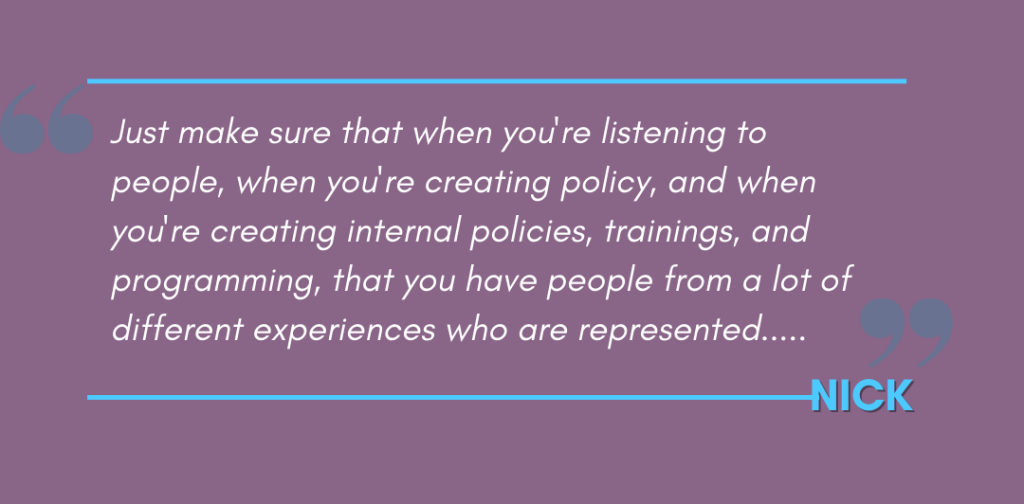
It’s no longer just theoretical.
So I would say, just, and I think the one thing that everyone can do is, make sure that a lot of people from different backgrounds are represented in the room, like, not just trans people, but you know, make sure that people of color are there, talk about people with disabilities getting abortions, you know, how about, like, how about disabled people, make sure disabled people have a seat at the table.
Just make sure that when you’re listening to people, when you’re creating policy, and when you’re creating internal policies, trainings, and programming, that you have people from a lot of different experiences who are represented. Kind of like what y’all are doing. Where you know, you’re not having one storyteller represent everyone. It’s people who have had different experiences, because we all have different insights that we can share.
And so, I do think that just making sure to elevate the voices of people who have had abortions, and have had these life experiences, goes a long way. I also think normalizing things like asking for people’s pronouns, and not saying, hey ladies, and as volunteers within a volunteer group, making sure that it’s a group that trans people are going to feel welcome in.
Credits:
Graphics Designed by Trevor Messersmith of 80east Design
Website Frame & Submenu by Black Digital Group
A convenient way to get the latest news and resources that help grantmakers maximize the impact on equity and justice
Sign me up for ROUNDUP now